boot Abarth Grande Punto 2010 Owner handbook (in English)
[x] Cancel search | Manufacturer: ABARTH, Model Year: 2010, Model line: Grande Punto, Model: Abarth Grande Punto 2010Pages: 207, PDF Size: 3.01 MB
Page 76 of 207
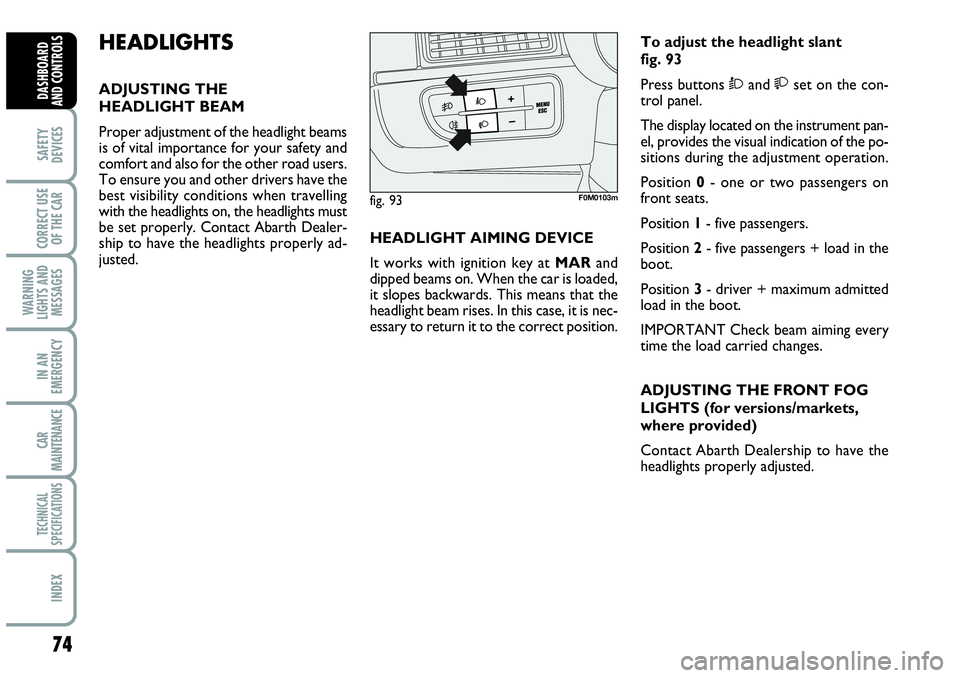
74
SAFETY
DEVICES
CORRECT USE
OF THE CAR
WARNING
LIGHTS AND
MESSAGES
IN AN
EMERGENCY
CAR
MAINTENANCE
TECHNICAL
SPECIFICATIONS
INDEX
DASHBOARD
AND CONTROLS
HEADLIGHTS
ADJUSTING THE
HEADLIGHT BEAM
Proper adjustment of the headlight beams
is of vital importance for your safety and
comfort and also for the other road users.
To ensure you and other drivers have the
best visibility conditions when travelling
with the headlights on, the headlights must
be set properly. Contact Abarth Dealer-
ship to have the headlights properly ad-
justed.HEADLIGHT AIMING DEVICE
It works with ignition key at MARand
dipped beams on. When the car is loaded,
it slopes backwards. This means that the
headlight beam rises. In this case, it is nec-
essary to return it to the correct position.To adjust the headlight slant
fig. 93
Press buttons Òand set on the con-
trol panel.
The display located on the instrument pan-
el, provides the visual indication of the po-
sitions during the adjustment operation.
Position 0- one or two passengers on
front seats.
Position 1- five passengers.
Position 2- five passengers + load in the
boot.
Position 3- driver + maximum admitted
load in the boot.
IMPORTANT Check beam aiming every
time the load carried changes.
ADJUSTING THE FRONT FOG
LIGHTS (for versions/markets,
where provided)
Contact Abarth Dealership to have the
headlights properly adjusted.
fig. 93F0M0103m
Page 116 of 207
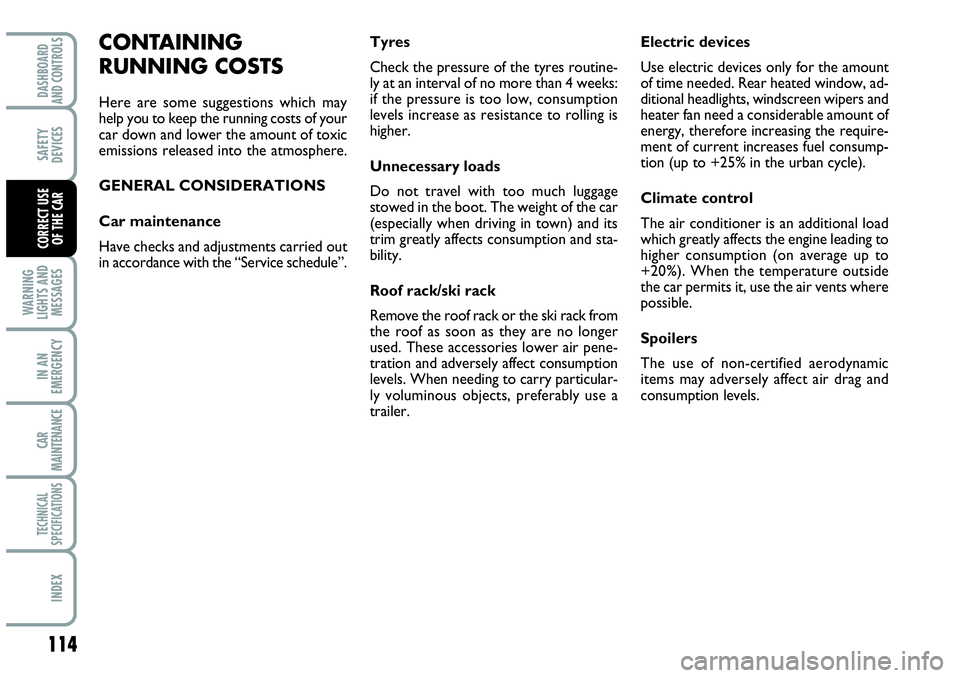
114
WARNING
LIGHTS AND
MESSAGES
IN AN
EMERGENCY
CAR
MAINTENANCE
TECHNICAL
SPECIFICATIONS
INDEX
DASHBOARD
AND CONTROLS
SAFETY
DEVICES
CORRECT USE
OF THE CAR
CONTAINING
RUNNING COSTS
Here are some suggestions which may
help you to keep the running costs of your
car down and lower the amount of toxic
emissions released into the atmosphere.
GENERAL CONSIDERATIONS
Car maintenance
Have checks and adjustments carried out
in accordance with the “Service schedule”.Tyres
Check the pressure of the tyres routine-
ly at an interval of no more than 4 weeks:
if the pressure is too low, consumption
levels increase as resistance to rolling is
higher.
Unnecessary loads
Do not travel with too much luggage
stowed in the boot. The weight of the car
(especially when driving in town) and its
trim greatly affects consumption and sta-
bility.
Roof rack/ski rack
Remove the roof rack or the ski rack from
the roof as soon as they are no longer
used. These accessories lower air pene-
tration and adversely affect consumption
levels. When needing to carry particular-
ly voluminous objects, preferably use a
trailer.Electric devices
Use electric devices only for the amount
of time needed. Rear heated window, ad-
ditional headlights, windscreen wipers and
heater fan need a considerable amount of
energy, therefore increasing the require-
ment of current increases fuel consump-
tion (up to +25% in the urban cycle).
Climate control
The air conditioner is an additional load
which greatly affects the engine leading to
higher consumption (on average up to
+20%). When the temperature outside
the car permits it, use the air vents where
possible.
Spoilers
The use of non-certified aerodynamic
items may adversely affect air drag and
consumption levels.
Page 137 of 207
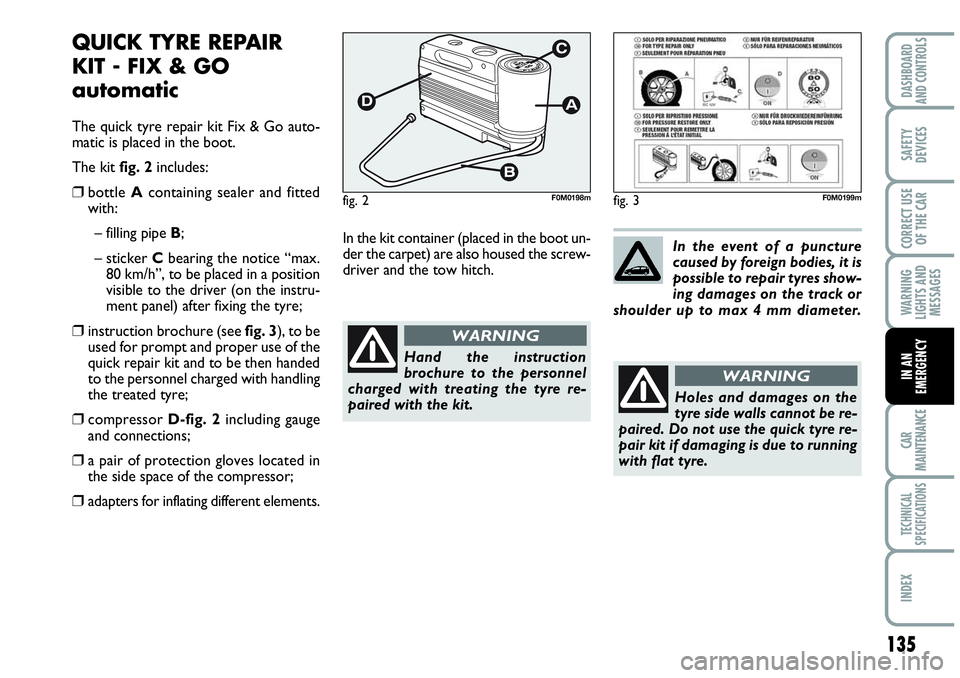
135
WARNING
LIGHTS AND
MESSAGES
CAR
MAINTENANCE
TECHNICAL
SPECIFICATIONS
INDEX
DASHBOARD
AND CONTROLS
SAFETY
DEVICES
CORRECT USE
OF THE CAR
IN AN
EMERGENCY
QUICK TYRE REPAIR
KIT - FIX & GO
automatic
The quick tyre repair kit Fix & Go auto-
matic is placed in the boot.
The kit fig. 2includes:
❒bottle A containing sealer and fitted
with:
– filling pipe B;
– sticker Cbearing the notice “max.
80 km/h”, to be placed in a position
visible to the driver (on the instru-
ment panel) after fixing the tyre;
❒instruction brochure (see fig. 3), to be
used for prompt and proper use of the
quick repair kit and to be then handed
to the personnel charged with handling
the treated tyre;
❒compressor D-fig. 2including gauge
and connections;
❒a pair of protection gloves located in
the side space of the compressor;
❒adapters for inflating different elements.In the kit container (placed in the boot un-
der the carpet) are also housed the screw-
driver and the tow hitch.
Hand the instruction
brochure to the personnel
charged with treating the tyre re-
paired with the kit.
WARNING
fig. 2F0M0198mfig. 3F0M0199m
In the event of a puncture
caused by foreign bodies, it is
possible to repair tyres show-
ing damages on the track or
shoulder up to max 4 mm diameter.
Holes and damages on the
tyre side walls cannot be re-
paired. Do not use the quick tyre re-
pair kit if damaging is due to running
with flat tyre.
WARNING
Page 142 of 207
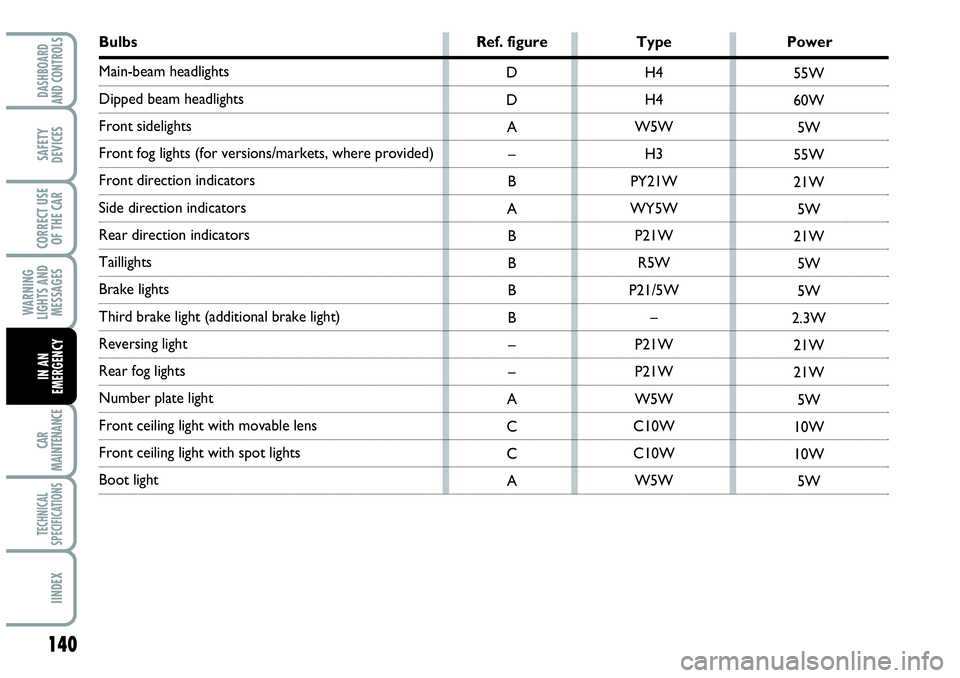
140
WARNING
LIGHTS AND
MESSAGES
CAR
MAINTENANCE
TECHNICAL
SPECIFICATIONS
IINDEX
DASHBOARD
AND CONTROLS
SAFETY
DEVICES
CORRECT USE
OF THE CAR
IN AN
EMERGENCY
Bulbs Ref. figure Type Power
Main-beam headlights
Dipped beam headlights
Front sidelights
Front fog lights (for versions/markets, where provided)
Front direction indicators
Side direction indicators
Rear direction indicators
Taillights
Brake lights
Third brake light (additional brake light)
Reversing light
Rear fog lights
Number plate light
Front ceiling light with movable lens
Front ceiling light with spot lights
Boot light H4
H4
W5W
H3
PY21W
WY5W
P21W
R5W
P21/5W
–
P21W
P21W
W5W
C10W
C10W
W5W D
D
A
–
B
A
B
B
B
B
–
–
A
C
C
A55W
60W
5W
55W
21W
5W
21W
5W
5W
2.3W
21W
21W
5W
10W
10W
5W
Page 149 of 207

147
WARNING
LIGHTS AND
MESSAGES
CAR
MAINTENANCE
TECHNICAL
SPECIFICATIONS
INDEX
DASHBOARD
AND CONTROLS
SAFETY
DEVICES
CORRECT USE
OF THE CAR
IN AN
EMERGENCY
BOOT LIGHT fig. 28
To change the bulb, proceed as follows:
❒ open the tailgate;
❒remove the light Alevering in the point
shown by the arrow;
❒open the protection Band replace the
snap-fitted bulb;
❒re-close the protective cover Bon the
lens;
❒refit the light Ainserting it in its cor-
rect position firstly on one end and
then on the other until it clicks into
place.PUDDLE LIGHTS
(for versions/markets,
where provided) fig. 29-30
To change the bulb, proceed as follows:
❒remove the light by pressing clip Awith
a screwdriver;
❒press the bulb protection cover sides
Bon the two fastening pins and turn it;
❒replace the snap-fitted bulb C;
fig. 28F0M0216mfig. 29F0M0217mfig. 30F0M0229m
❒refit bulb protection cover fitting the
two fastening pins;
❒refit the ceiling light inserting first end
Dand then pressing the other end un-
til hearing the locking click of the clip.
Page 153 of 207
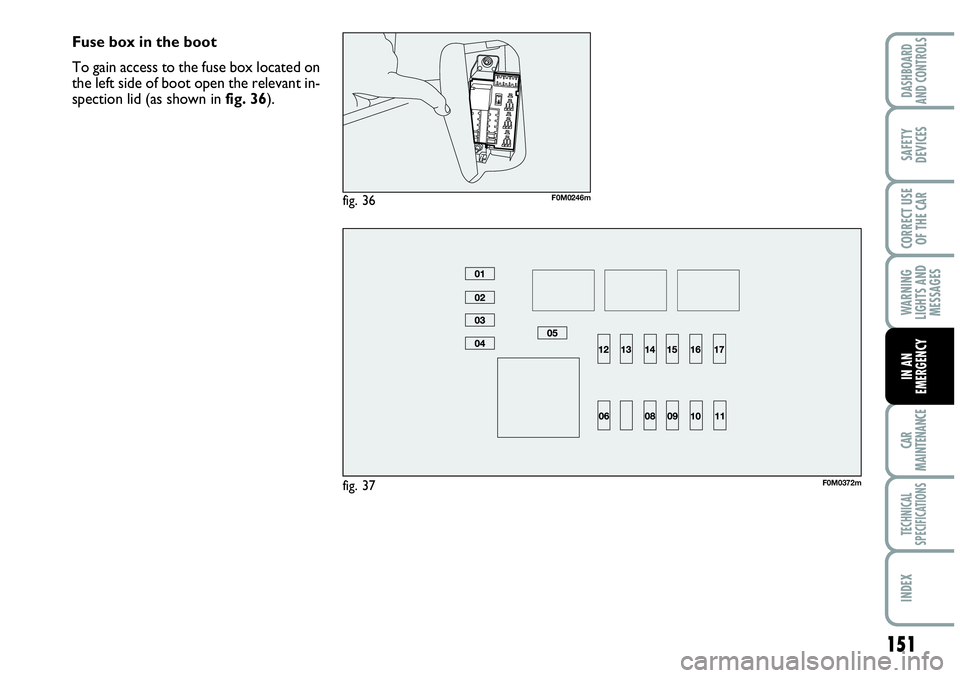
151
WARNING
LIGHTS AND
MESSAGES
CAR
MAINTENANCE
TECHNICAL
SPECIFICATIONS
INDEX
DASHBOARD
AND CONTROLS
SAFETY
DEVICES
CORRECT USE
OF THE CAR
IN AN
EMERGENCY
Fuse box in the boot
To gain access to the fuse box located on
the left side of boot open the relevant in-
spection lid (as shown infig. 36).
fig. 37F0M0372m
fig. 36F0M0246m
Page 158 of 207
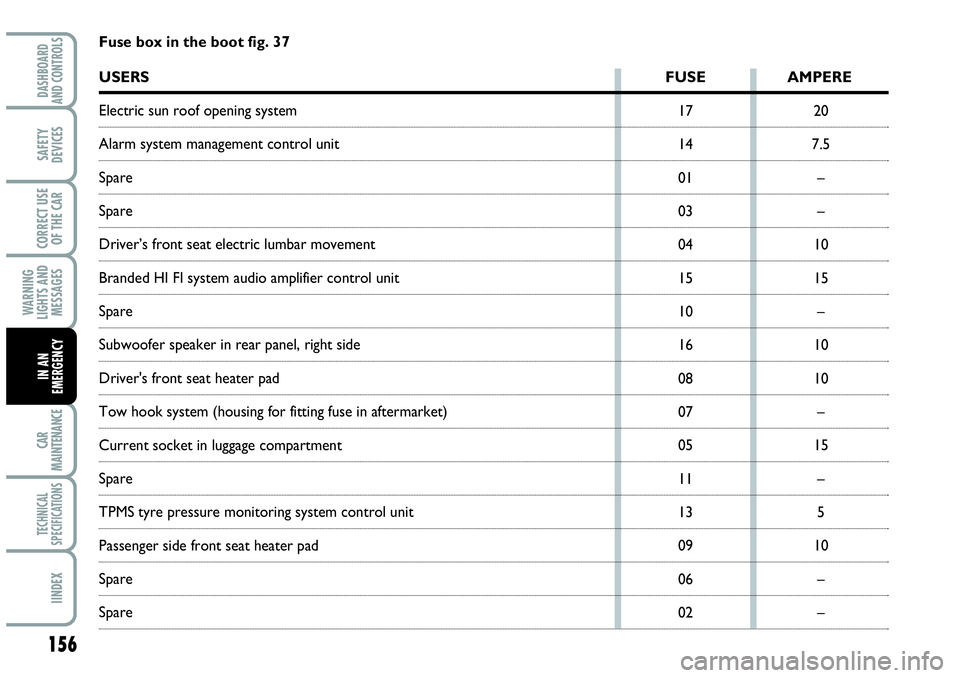
156
WARNING
LIGHTS AND
MESSAGES
CAR
MAINTENANCE
TECHNICAL
SPECIFICATIONS
IINDEX
DASHBOARD
AND CONTROLS
SAFETY
DEVICES
CORRECT USE
OF THE CAR
IN AN
EMERGENCY
17
14
01
03
04
15
10
16
08
07
05
11
13
09
06
0220
7.5
–
–
10
15
–
10
10
–
15
–
5
10
–
– Fuse box in the boot fig. 37
USERSFUSE AMPERE
Electric sun roof opening system
Alarm system management control unit
Spare
Spare
Driver’s front seat electric lumbar movement
Branded HI FI system audio amplifier control unit
Spare
Subwoofer speaker in rear panel, right side
Driver's front seat heater pad
Tow hook system (housing for fitting fuse in aftermarket)
Current socket in luggage compartment
Spare
TPMS tyre pressure monitoring system control unit
Passenger side front seat heater pad
Spare
Spare
Page 161 of 207

159
WARNING
LIGHTS AND
MESSAGES
CAR
MAINTENANCE
TECHNICAL
SPECIFICATIONS
INDEX
DASHBOARD
AND CONTROLS
SAFETY
DEVICES
CORRECT USE
OF THE CAR
IN AN
EMERGENCY
TOWING THE CAR
The tow ring provided with the car is
housed in the tool box under the boot
mat.
TOW RING HOOKING fig. 39
Proceed as follows:
❒release the cap A;
❒take the tow hook Bfrom the sup-
port;
❒tighten the ring on the rear or front
threaded pin.
When towing, remember that
without the help of the ser-
vobrake and power steering, a greater
effort is required on the pedal and
steering wheel. Do not use flexible ca-
bles for towing and avoid jerks. During
towing operations make sure that fas-
tening the joint to the car does not
damage the components in contact
with it. When towing the car, you must
comply with the specific traffic regu-
lations regarding the tow ring and how
to tow on the road.
WARNING
fig. 39F0M043Ab
Page 165 of 207

163
WARNING
LIGHTS AND
MESSAGES
TECHNICAL
SPECIFICATIONS
INDEX
DASHBOARD
AND CONTROLS
SAFETY
DEVICES
CORRECT USE
OF THE CAR
IN AN
EMERGENCY
CAR
MAINTENANCE
30 60 90 120 150 180
●●●●● ●
●●●●● ●
●●●●● ●
●●●●● ●
●●●●● ●
●●●●● ●
●●
●
●●●●● ●
●●●●● ●
●●
●● ●
SERVICE SCHEDULE
Service coupons shall be performed every 30,000 km
Thousands of km
Check tyre conditions/wear and adjust pressure if required
Check light system operation (headlights, direction indicators,
hazard lights, boot lights, passenger compartment lights,
instrument panel warning lights, etc.)
Check windscreen wiper/washer operation
Check front disk brake pad conditions and wear front and rear
Sight inspect the conditions of: bodywork,
underbody protection, pipes and hoses
(exhaust - fuel - brakes), rubber parts
(boots, sleeves, bushes, etc.)
Check cleanness of locks, bonnet and boot and lever
cleanness and lubrication
Sight inspect accessory drive belt conditions
Replace accessory drive belt/s
Check and adjust handbrake lever stroke, if required
Check exhaust emissions
Check antievaporation system
Replace air cleaner cartridge
Page 167 of 207
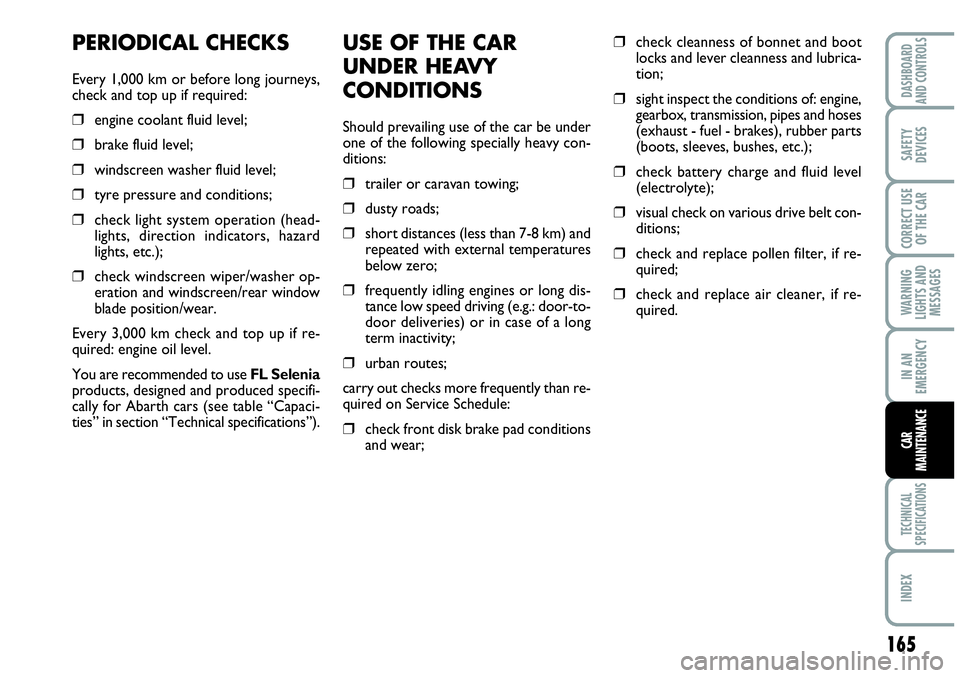
USE OF THE CAR
UNDER HEAVY
CONDITIONS
Should prevailing use of the car be under
one of the following specially heavy con-
ditions:
❒trailer or caravan towing;
❒dusty roads;
❒short distances (less than 7-8 km) and
repeated with external temperatures
below zero;
❒frequently idling engines or long dis-
tance low speed driving (e.g.: door-to-
door deliveries) or in case of a long
term inactivity;
❒urban routes;
carry out checks more frequently than re-
quired on Service Schedule:
❒check front disk brake pad conditions
and wear;
❒check cleanness of bonnet and boot
locks and lever cleanness and lubrica-
tion;
❒sight inspect the conditions of: engine,
gearbox, transmission, pipes and hoses
(exhaust - fuel - brakes), rubber parts
(boots, sleeves, bushes, etc.);
❒check battery charge and fluid level
(electrolyte);
❒visual check on various drive belt con-
ditions;
❒check and replace pollen filter, if re-
quired;
❒check and replace air cleaner, if re-
quired.
PERIODICAL CHECKS
Every 1,000 km or before long journeys,
check and top up if required:
❒engine coolant fluid level;
❒brake fluid level;
❒windscreen washer fluid level;
❒tyre pressure and conditions;
❒check light system operation (head-
lights, direction indicators, hazard
lights, etc.);
❒check windscreen wiper/washer op-
eration and windscreen/rear window
blade position/wear.
Every 3,000 km check and top up if re-
quired: engine oil level.
You are recommended to use FL Selenia
products, designed and produced specifi-
cally for Abarth cars (see table “Capaci-
ties” in section “Technical specifications”).
165
WARNING
LIGHTS AND
MESSAGES
TECHNICAL
SPECIFICATIONS
INDEX
DASHBOARD
AND CONTROLS
SAFETY
DEVICES
CORRECT USE
OF THE CAR
IN AN
EMERGENCY
CAR
MAINTENANCE